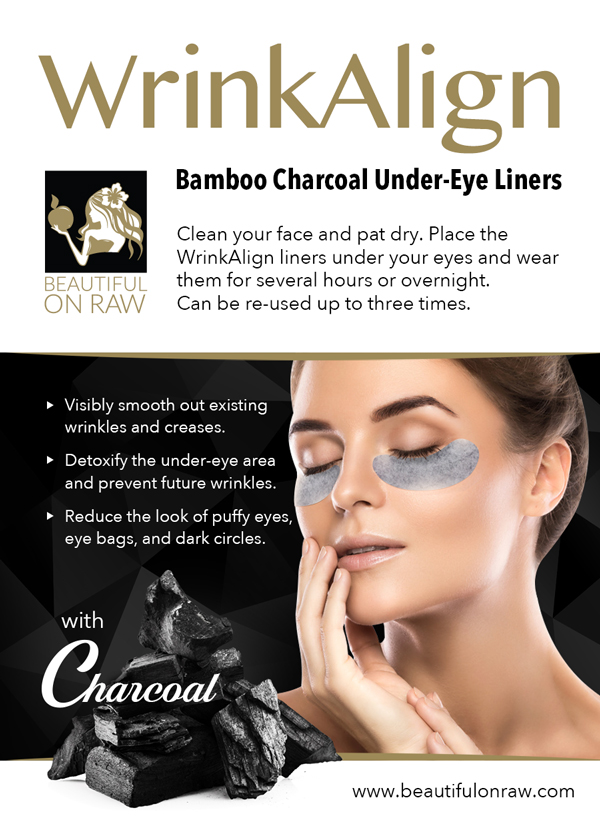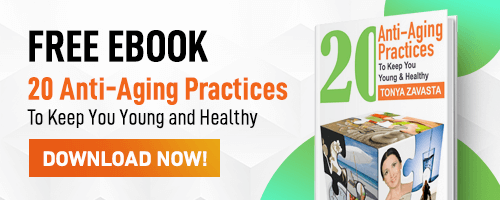Bamboo Charcoal Under-Eye Patches for Puffy Eyes, Eye Bags and Dark Circles

For years I used paper tape under my eyes to keep the area wrinkle-free. But in my late 50s I was challenged to find something that would work more effectively. Here it is… my Bamboo Charcoal WrinkAlign Liners, in packets of two for your delicate under-eye area.
How can Bamboo Charcoal Liners improve the look of your under-eye areas?
The filtering and purifying powers of charcoal have been recognized for centuries. Ancient practitioners and modern science alike know its value. Think about the numerous places and ways we use activated charcoal already for health-related purposes.
Water filters. Vacuum cleaners. Poisoning treatments. Treatments for stomach infections. Treating nausea. The list goes on. Consider: We can take it internally and expect it to help heal us. Can we expect it to be equally useful on the outside? It’s at least reasonable to think claims about skin benefits of activated charcoal are worth checking out.
Do you know the difference between absorption and adsorption? Just one little letter—a b versus a d. Yet it is important for understanding how our under-eye liners work.
Absorption happens when one substance enters completely into another. Analogy: You wipe up a spill with a paper towel, and the liquid’s molecules soak into the towel.
Adsorption happens when one substance attaches to another. Analogy: When you dust, particles stick to your dusting cloth.
Raw charcoal and activated charcoal. Here’s another distinction you need to know. We’ll skip the heavy-duty chemistry. Suffice it to say that the activation of charcoal gives it much greater surface area, hugely increasing the charcoal’s adsorption ability—its “stick-ability,” if you will.
You’ll not find any purer or more natural charcoal than that produced from quality bamboo of even density and consistency.
Bamboo charcoal’s stick-ability is extraordinary. The millions of tiny spaces in a piece of activated bamboo charcoal attract impurities to its surface. Because there are so many little spaces for those toxins to enter, one layer of our WrinkAlign can attract and retain a remarkable volume of harmful substances and, practically speaking, help make you look younger.
Our Bamboo Charcoal Under-Eye Patches are made to fit your under-eye area… they will fit you perfectly.
You can use your Under-Eye WrinkAlign Liners overnight, or use them for an hour or two when you first wake up. Either way, you might notice that your overnight creases will be miraculously smoothed… perhaps, gone entirely. You’ll be ready to face the day, fresh and new. And you’ll never think about Botox again!
Ingredients: Water, Glycerin, Bamboo Charcoal, Sodium Polyacrylate, Croscarmellose (emulsifier), Polybutene (viscosity increasing agent), Hamamelis Virginiana (Witch Hazel Plant) Extract, Niacinamide (a derivative of Vitamin B3), Tartaric Acid, Glycyrrhetinic Acid, Polyglutamic Acid, Disodium EDTA, Diazolidinyl urea, Phenoxyethanol, Iodopropynyl Butylcarbamate.
Sodium polyacrylate is a thickening agent. It is a polymer, a long chain of molecules joined end-to-end. Because the sodium acrylate portions of the ingredient interact very strongly with water molecules, the water molecules in the product become less free to move around. Their movement is restricted, because the sodium polyacrylate is acting as a sort of magnet to attract them and hold them close. This results in a thickening of the solution, as the water molecules no longer have the freedom they would have in a solution of pure water. Acrylates of various sorts are extremely common “gelling agents” used in cosmetics, and they produce gels of superior texture and stability.
Croscarmellose is used as both a viscosity modifier (thickening agent) as well as an emulsifier. Emulsifiers are necessary when oily / oil-soluble ingredients are included in a water formulation. Oils and water typically don’t like to mix; the oils just float on top of the water. Including an emulsifier allows the oil to be suspended in the water in the form of microscopic droplets, and is key for the production of products such as lotions, creams, and some gels.
Polybutene is another viscosity increasing agent, which affects the thickness of the product. In order to get the best possible “skin feel,” it’s often best to include multiple thickeners in the same product. It’s extremely common, and provides the skin with a more interesting range of sensations than can be achieved with just a single thickener.
Tartaric acid is a natural fruit acid found in grapes. It’s used to adjust the acidity of the product. Our skin has a natural acidity, due to the makeup of the cells at the surface. If a product does not have a similar acidity to the skin (“pH-balanced”), applying it to skin can result in redness and irritation. Tartaric acid adjusts the acidity of the product to best match the acidity of skin. This results in a product with minimal irritation potential.
Glycyrrhetinic Acid is the primary active ingredient found in licorice extract. We use the purified, individual additive to avoid exposing the skin to other ingredients found in the botanical extract which might have undesirable properties. The glycyrrhetinic acid acts as an antioxidant and helps to protect the skin from oxidative damage. It also soothes the skin, helping to reduce irritation. You can read more about glycyrrhetinic acid and its use in cosmetics at the following link.
https://www.paulaschoice.com/ingredient-dictionary/antioxidants/glycyrrhetinic-acid.html
Polyglutamic acid is an extremely powerful hydrating agent. It’s produced from fermented soybeans, and can hold many thousand times its own weight in water. Applying it to the skin results in thorough hydration of both the upper and lower layers of the skin. It’s similar to, but more powerful than, hyaluronic acid which is a more common hydrating agent found in high-end cosmetics. You can read more about polyglutamic acid at the following link.
https://www.refinery29.com/en-gb/polyglutamic-acid-skincare-benefits
Disodium EDTA is used as a chelating agent. Even though we strive to use the purest of materials, trace amounts of metal ions like iron and calcium can often find their way into the products container. This can happen during production or after the product is sold, in the consumers home. These metal ions can accelerate microbial growth and decomposition of certain additives. A chelating agent (like EDTA) is a “floppy” molecule that can wrap around, or chelate, the metal ions and stick. This renders the metal ions harmless and results in a product remaining fresh longer.
Diazolidinyl urea, Phenoxyethanol, Iodopropynyl Butylcarbamate are all preservatives. Each formulation has unique preservation requirements. We use the preservatives we believe result in the safest customer experience.
Some of these ingredients sound intimidating, don't they? Are they safe? Keep in mind what the ancient sage Paracelsus once said: “It’s the dose that makes the poison.” This remark became a basic principle of toxicology. Nothing is inherently completely good or bad. It all depends on the dose and intended use.
The expression natural preservative is a contradiction. Extracts from fruits, vegetables and plants will go bad within a day, left on your bathroom sink. For any water-based cosmetics to have a reasonable shelf life, preservatives, emulsifies and stabilizers are a must. Without them, we can expect harmful bacteria to start growing right away.
I used these WrinkAligns for months before offering them to you. I believe they’re totally safe. But should you have any reservations, please consider the alternative path of using simple paper tape. See the video on this page. Would you rather not use a man-made product? No problem! Make your own cosmetics. More information here.
